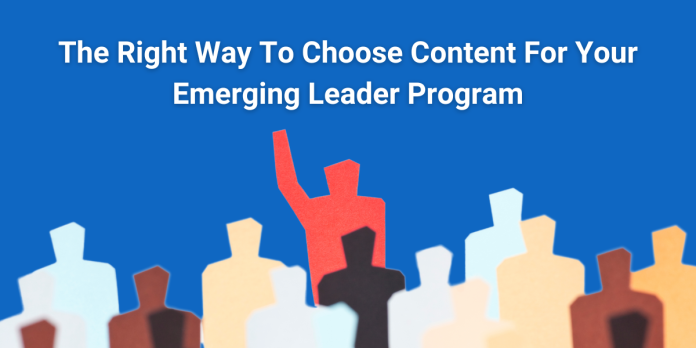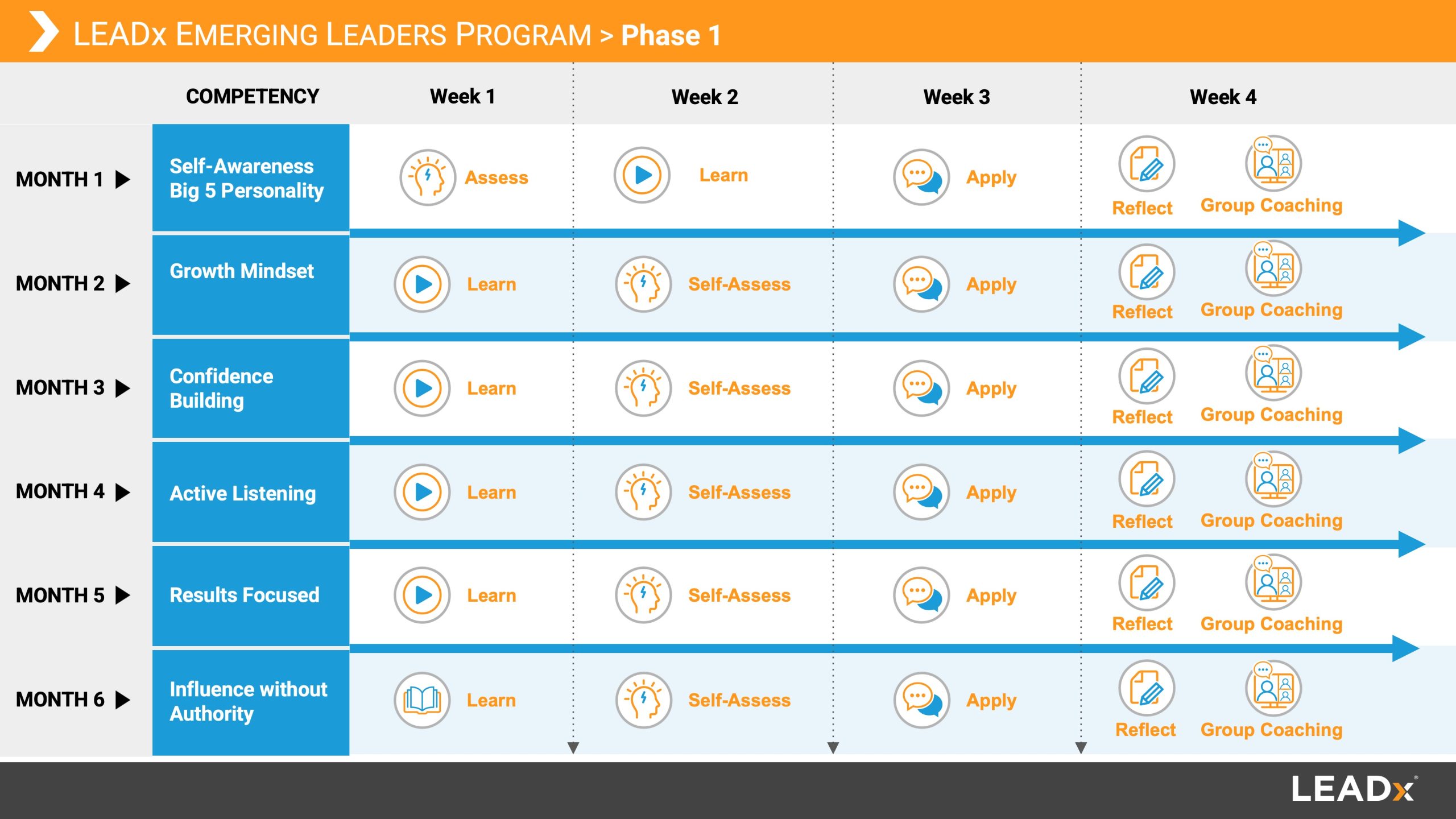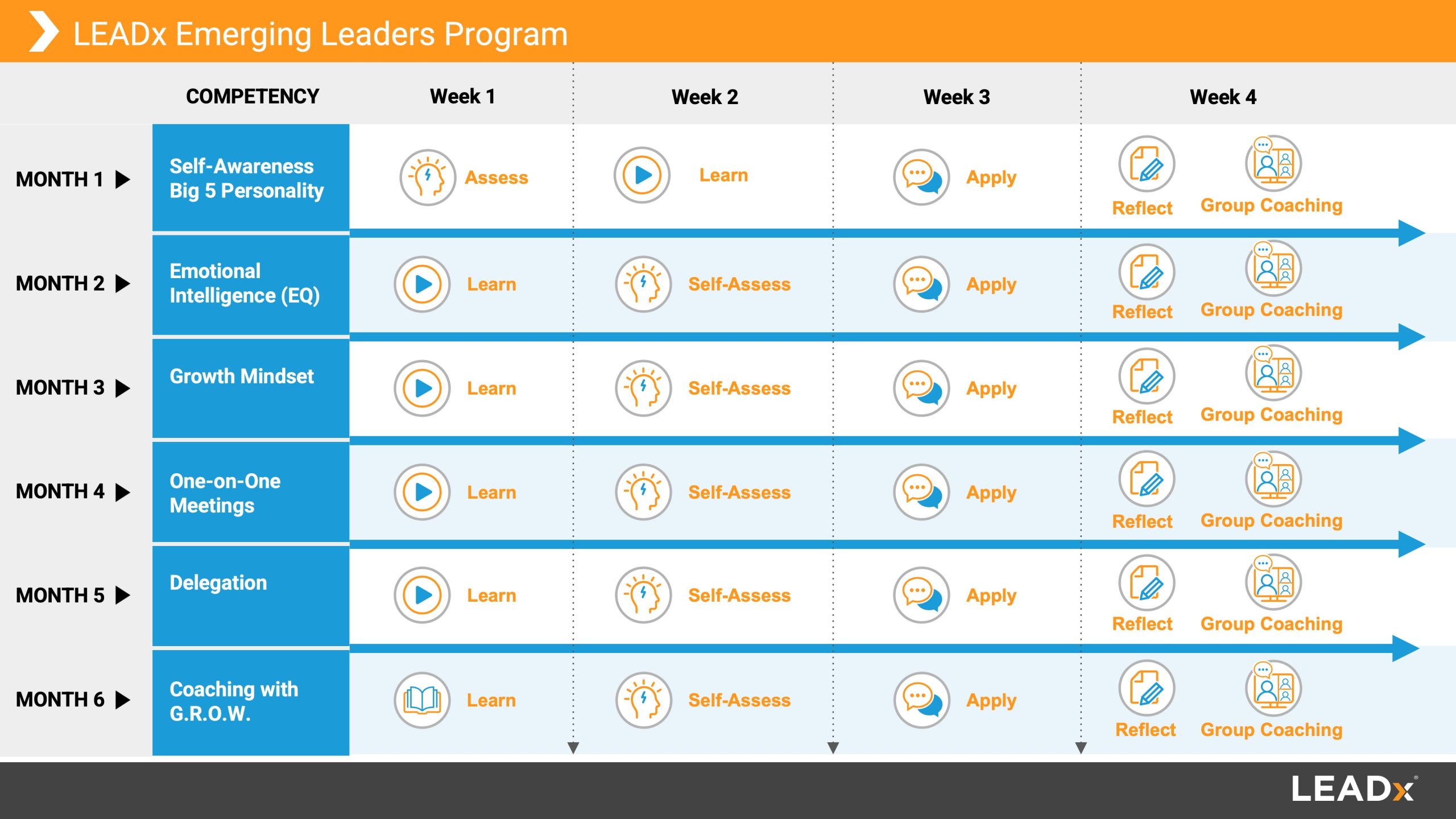
How do you choose the right topics for your emerging leader program? Throughout hundreds of conversations with heads of leadership development, “content” consistently shows up as one of the biggest stumbling blocks.
This problem is unique to emerging leader programs. Other leadership development programs tend to be more straightforward when it comes to topic selection. For new managers, you choose content like “transition to manager” and “one-on-one meetings.” For middle managers, you choose content like “strategic thinking” and “innovation.” For emerging leader programs, however, your options are a bit less obvious.
 Here’s an example from a medium-sized biotech company was an emerging leader program that focused on “people leader” topics. The problem? Emerging leaders had no direct reports to practice with. Their learning remained theoretical. Here’s a second example, which suffered from the exact opposite problem. A large retail company developed a curriculum of self-leadership skills for a cohort of emerging leaders who would all step into management positions in a matter of months. The self-leadership skills were all useful, but the cohort of emerging leaders soon found themselves leading people without a taste for what that entailed. The day-in, day-out demands hit them like a ton of bricks. Both programs were well-intentioned, but their content selection got in the way.
Here’s an example from a medium-sized biotech company was an emerging leader program that focused on “people leader” topics. The problem? Emerging leaders had no direct reports to practice with. Their learning remained theoretical. Here’s a second example, which suffered from the exact opposite problem. A large retail company developed a curriculum of self-leadership skills for a cohort of emerging leaders who would all step into management positions in a matter of months. The self-leadership skills were all useful, but the cohort of emerging leaders soon found themselves leading people without a taste for what that entailed. The day-in, day-out demands hit them like a ton of bricks. Both programs were well-intentioned, but their content selection got in the way.
To avoid letting the same happen to you, think of emerging leader programs as falling into two main buckets.
Type 1: Self-Leadership Skills
Target self-leadership skills when your audience is broad and the timeline toward a people leadership role is long or unknown. That way your participants can immediately take the skills you train and practice them on the job. Here’s an example of what a self-leadership curriculum might look like:

Each topic on the example curriculum map here is immediately applicable on the job and it will be a valuable skill when that person steps into people leadership.
Self-awareness—Developing self-awareness helps emerging leaders understand their behavioral tendencies and how they come across to others. As leaders, self-awareness is a foundational skill for thoughtful communication, emotional regulation, and decision-making.
Growth mindset—This mental framework helps emerging leaders learn and grow faster. It also decreases stress. As leaders, a growth mindset will help them communicate about success and failure with their team members in a more motivating way.
Confidence–Confidence empowers emerging leaders to step up, take on additional responsibilities, earn a seat at the table with their leader, and not let self-doubt hijack them. As leaders, confidence is critical to their ability to make sound decisions and lead their teams through challenges.
Active listening–Active listening will improve your emerging leaders’ communication skills. As leaders, active listening will help them understand what their direct reports are really feeling so they can inspire, motivate, and care for team members.
Results-focused—Instead of getting caught up in day-to-day routines, your emerging leaders will be able to zoom out and see what work will have the biggest impact. As they step into leadership positions, this mindset equates to more empowered and more agile teams.
Influence without authority–This will help your emerging leaders understand how to communicate in an influential way. As leaders, they won’t just rely on their authority for influence.
Of course, the above curriculum is just one example. This curriculum can easily be lengthened and the topics can be adjusted. The main idea is to show a sample selection of skills that are immediately applicable and hold value in the transition to people leader.
Type 2: Includes “Leading Others” Skills Like “One-on-One Meetings”
The second type of emerging leader program is where your cohort will go on to become first-line leaders in a short period of time. In this type of program, you want your content to include critical for first-time leaders. Here’s an example six-month curriculum:

In this example, you’re giving your emerging leaders a few self-leadership skills they can take and apply immediately: self-awareness, emotional intelligence, and growth mindset. At the same time, you also give them a foundational overview of three of the most critical people leadership skills: One-on-one meetings, delegation, and GROW coaching.
One note of warning for type 2 programs: The same problem still exists with this audience. Even though the timeline to leadership is shorter, these emerging leaders still don’t have direct reports to practice people leadership skills with. To overcome this problem, implement a repertoire of experiential learning and practicable exercises. You might consider implementing one of the following ten tactics:
- Simulations—Run emerging leaders through realistic first-line leader scenarios. Record their responses. Have them re-watch and self-critique. Bring in feedback from current first-line leaders, their manager, their peers, and your leadership development team.
- Group coaching—Give emerging leaders the opportunity to explore challenges, share experiences, ask questions, and practice. All with an expert coach.
- Peer role plays and feedback—Have emerging leaders practice with each other. Record, re-watch, and reflect.
- Personalized nudges: Send specific behavioral nudges to reinforce key insights and behaviors. Nudges should be highly actionable and link to handy resources (e.g. fillable PDFs, pithy videos, and worksheets).
- LiveCoach—Give your emerging leaders platform-based access to a human coach. They can work with this coach to do roleplays, ask detailed questions, and get additional resources.
- Formalized conversations with managers—Have emerging leaders work through formalized conversations with their managers. Managers work through a pre-set list of questions and examples that will help emerging leaders see what these skills look like on the job. For example, emerging leaders can talk with their managers about the GROW coaching model and how they use it in their one-on-ones.
- Job shadowing—Give emerging leaders direct exposure to first-line leadership. Use guided questions to facilitate reflection on the specific skills that your emerging leaders are learning.
- Community of practice—Create a virtual community where your emerging leaders can share ideas, challenges, and questions with each other. As an added bonus, keep alumni in the community. That way, alumni in first-line leadership positions can help share their experience.
- Job aids, worksheets, reflection exercises, and observational exercises—Use each of these tools to immerse your emerging leaders in key ideas. Each engagement with an exercise will help solidify new habits.
- Digital badges linked to practice—As a mandatory part of program completion, include a set number of application exercises and practice. Make sure this is trackable. For example, your emerging leaders may need to complete at least 60% of all practice exercises, one simulation, one conversation with their manager, and start and engage with at least five conversations in your community of practice.
While you could apply all ten of these tactics to any leadership development program, they become especially important when “on the job application” isn’t yet possible.
Three Additional Content Considerations: Competencies, Functional Content, and Your Grand Finale
Here are three other important content considerations:
Should your topics be based on your company’s competencies? If so, you should still align your competencies with one of the two “types” previously mentioned.
Should you include functional content? I advise you to “tease” functional content with shadowing, mentorship, and manager conversations. However, I don’t like to push too much of it prior to actual people leadership.
How do you want to conclude your program? I won’t get too in-depth here, but considerations include:
- A capstone project—This is a great way to show your program’s impact, create a tangible end-product, and finish your program on a memorable note. In Olympus’s emerging leader program, for example, participants took real business ideas and developed a business plan. They then presented this plan to over thirty senior leaders. Four were selected to move forward.
- An inspirational story from an alumni—You can leave participants with a real story of how your leadership training impacted someone’s life. Whether it’s personal or tied directly to the business, stories like this stick with people and motivate them to keep practicing. At Lippert, the leadership development team found that asking graduates to share a personal story of success around their goals acted as a spark for reflection and engagement.
- A graduation award—Awards can help market your program and foster your culture in a genuine way. For example, at Collectors, a company that authenticates collectible items, graduates were awarded a custom baseball card with their picture on the front and personal stats on the back of the card.
From Insights to Action
The most important thing to remember from this article is to make an active decision about whether you’re tailoring your content to a type 1 or type 2 audience. With that in mind, everything else should fall into place.






